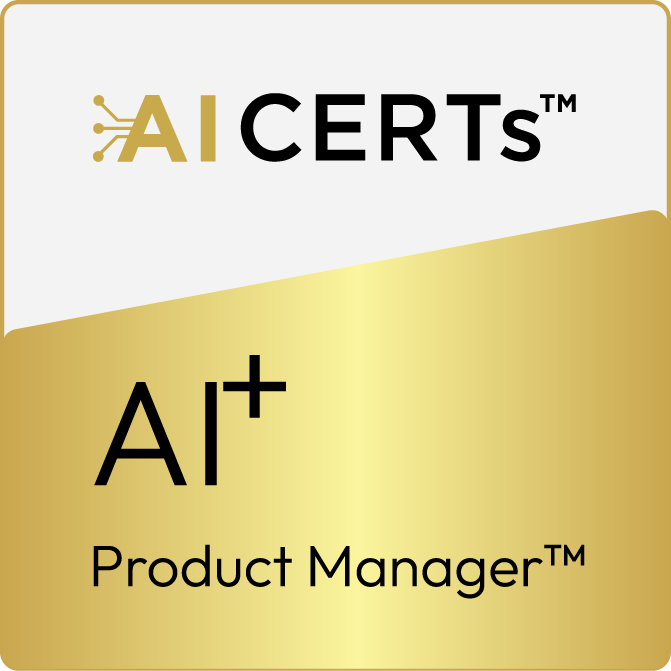Description
AI+ Product Manager (1 Day)
Program Detailed Curriculum
Executive Summary
This AI+ for Product Managers certification offers a comprehensive foundation in artificial intelligence
tailored for product management professionals. It begins by demystifying AI, exploring its various
branches, and delving into specific AI applications within product management. Students will learn about
the evolving role of an AI Product Manager and how this position is critical in bridging the gap between
cutting-edge technology and practical, market-driven solutions. The module further highlights the
significance of AI in product development, detailing the benefits and competitive advantages it brings to
the table. By the end of this course, participants will possess a solid understanding of AI fundamentals and
their application in enhancing product development processes.
Course Prerequisites
Understanding the basics of digital technologies and their influence on various aspects of professional
life
Interest in learning about the integration of AI technologies within product development
Participants should have an open mindset towards learning new concepts and technological
developments.
Module 1
Introduction to Artificial Intelligence (AI) for Product Managers
1.1 Understanding the Basics of Artificial Intelligence
What is Artificial Intelligence: Understand fundamental concepts, terminologies, and applications of artificial
intelligence, exploring its definition and scope in various fields.
Branches of AI: Trace the historical development of artificial intelligence, examining key milestones, breakthroughs,
and societal impacts shaping its evolution.
Deep Dive into AI Applications for Product Management: Delve into the complexities of artificial intelligence,
analyzing ethical considerations, biases, and emerging trends in AI research and application.
The Role of an AI Product Manager: Explore the critical responsibilities and unique challenges faced by product
managers in AI-driven projects, emphasizing the blend of technical knowledge and strategic vision required.
1.2 Importance of AI
Benefits of AI for Product Development: Examine how artificial intelligence enhances product development
processes, focusing on increased efficiency, innovation, and personalized customer experiences.
Challenges of AI for Product Development: Navigating through AI’s complexities poses challenges in product
development, including ethical considerations, bias mitigation, and ensuring seamless integration for optimal
outcomes.
Module 2
Fundamentals of Machine Learning
2.1 Introduction to Machine Learning
How Does Machine Learning Work: Explores the step-by-step process of machine learning, from data collection to
model deployment, highlighting how algorithms adjust based on data to automate decision-making.
Types of Machine Learning: Introduces supervised, unsupervised, and reinforcement learning, detailing their
applications, differences, and impacts on technology and society.
2.2 Data Preparation in ML model
Why Do We Need Data Preprocessing: Discusses the crucial role of preprocessing in enhancing model accuracy by
preparing raw data for analysis, including cleaning, normalizing, and transforming inputs.
Data Preprocessing Steps in Machine Learning: Major Tasks Involved: Outlines the essential tasks in data
preprocessing, such as cleaning, integration, transformation, and reduction, to improve data quality for modeling.
Hands-On Example of Preprocessing Data using Pandas: Provides a practical example of using Pandas for data
preprocessing, showcasing techniques to handle missing values, duplicates, and outliers, followed by data scaling
and splitting for machine learning models.
What If We Ignore Data Processing: Highlights the consequences of skipping data preprocessing, including poor
model performance, overfitting, biased results, and longer training times, underscoring its importance in the ML
pipeline.
Hands-On Exercise: Offers a comprehensive exercise that includes importing libraries, dataset exploration, feature
engineering, data splitting, model development, and evaluation, reinforcing the practical application of machine
learning concepts.
Module 3
AI Product Development Lifecycle
3.1 Exploring How AI Can Be Leveraged in Ideation and Conceptualization
The Integration of AI into Product Development: Explore how AI revolutionizes product development, from
ideation to market launch, by analyzing consumer behavior and enhancing decision-making.
Role of AI in Product Development: Delve into AI’s pivotal role in redefining product development processes,
forecasting trends, and optimizing product designs for improved market fit and innovation.
AI Transforming Product Development: Discuss AI’s transformative impact on various aspects of product
development, including project management efficiency, strategic decision-making, and the simplification of
software requirement gathering.
Merits of AI in Product Development: Highlight the benefits of AI integration, such as cost reduction, enhanced
decision-making, process optimization, rapid development, and the production of high-quality, market-aligned
products.
Different Stages of AI Product Development: Outline the comprehensive stages of AI product development, from
identifying business objectives and preparing data to deploying AI solutions and maintaining their effectiveness.
Use Cases of AI for Product Development in Different Industries: Examine practical examples of AI applications
across industries, showcasing its capability to innovate product development in fields such as manufacturing,
healthcare, and automotive.
3.2 Prototyping and Testing: Explore Methods for Prototyping and Testing AI-driven Products Effectively
Methods for Prototyping and Testing AI-driven Products: Introduce effective strategies for prototyping and
testing AI products, emphasizing rapid experimentation, user feedback integration, and iterative refinement to
ensure product viability and user satisfaction.
Best AI Tools for Product Managers: Provide an overview of essential AI tools that support product managers in
tasks like market research, data-driven decision-making, customer insights gathering, agile project management,
and feedback analysis to streamline the product development process.
Module 4
AI Ethics and Bias
4.1 Understanding Ethical Considerations: Examine the Ethical Implications of AI Products and the
Responsibility of Product Managers
Bias and Fairness: Discusses the challenge of inherent biases in AI algorithms and emphasizes the importance of
identifying and mitigating these biases to ensure equitable outcomes.
Privacy and Data Protection: Focuses on the critical need to protect user data and maintain privacy in AI
applications, ensuring trust and compliance with data protection laws.
Transparency and Explainability: Highlights the necessity for AI systems to be transparent and explainable,
allowing users to understand how decisions are made.
Accountability and Responsibility: Underlines the responsibility of product managers and developers in the ethical
deployment of AI products, including addressing adverse consequences.
Safety and Reliability: Examines the importance of ensuring AI products are safe and reliable, especially in critical
applications like healthcare and autonomous driving.
Social Impact and Equity: Explores AI’s potential societal impacts, emphasizing the need to ensure technologies
benefit all segments of society equitably.
Regulatory Compliance: Covers the significance of adhering to legal and regulatory standards in the development
and deployment of AI products.
Ethical Decision-Making: Stresses integrating ethical considerations throughout the AI product development
lifecycle, from ideation to deployment.
Continuous Monitoring and Review: Advocates for the ongoing evaluation of AI products to adapt to ethical
considerations dynamically.
4.2 Mitigating Bias: Learn Strategies to Identify and Address Bias in AI Algorithms and Products
Strategies for Identifying & Addressing Bias in AI Algorithms and Products: Presents methods to detect and
correct biases in AI, ensuring fairness.
How to Fix Biases in AI and Machine Learning Algorithms: Provides approaches for rectifying biases in AI models
to promote fairness and accuracy.
Tools to Reduce Bias: Introduces tools and frameworks designed to identify and mitigate bias in AI algorithms and
datasets.
Module 5
AI Implementation Strategies
5.1 Integration with Existing Products: Explore Methods for Integrating AI Features Into Existing
Products Seamlessly
Steps for Successful AI Integration: Guides on incorporating AI into your products effectively, covering each critical
stage from conception to deployment.
Understanding the Potential of AI in Your Product: Emphasizes the importance of recognizing how AI can
enhance your product’s capabilities and user experience.
Identifying Suitable AI Technologies: Offers insights on selecting the right AI technologies that align with your
product goals and industry standards.
Preparing Your Data for AI Integration: Highlights the significance of data preparation, including cleaning and
structuring, for successful AI implementation.
Implementing AI in Your Product: Discusses the practical aspects of integrating AI functionalities into your
product, ensuring seamless operation.
Selecting AI Tools and Frameworks: Provides guidance on choosing the best AI tools and frameworks that fit your
product’s specific needs and objectives.
Developing AI Models: Covers the essentials of building AI models tailored to your product’s requirements, ensuring
they deliver accurate and relevant results.
Deploying AI Features: Focuses on the deployment of AI features within your product, ensuring they work
effectively in real-world scenarios.
Monitoring and Improving AI Performance: Stresses the continuous monitoring of AI performance and the
importance of iterative improvements based on feedback and data analysis.
Examples of AI integrations: Showcases successful case studies of AI integration across different industries, offering
valuable insights and inspiration.
Methods to Integrate AI into an App: Describes various strategies and best practices for embedding AI capabilities
into applications, enhancing their functionality.
5.2 Stakeholder Management: Understand How to Communicate AI Initiatives Effectively with
Stakeholders and Gain their Support
Key Steps in the Stakeholder Management Process: Outlines the essential steps in managing stakeholders
effectively, ensuring their needs and concerns are addressed throughout the product development process.
Stakeholder Management Strategies for Product People: Offers strategies for product managers on how to
engage and manage stakeholders efficiently, fostering positive relationships and support for the product.
Benefits of Stakeholder Management for Product People: Highlights the advantages of effective stakeholder
management, including improved decision-making, increased support, and enhanced product success.
Roles of Stakeholders in Product Management: Defines the diverse roles stakeholders play in the product
management process and how their input can contribute to the product’s development and success.
What Stakeholders Really Want: Provides insights into the expectations and priorities of stakeholders in relation to
product development, emphasizing the importance of understanding and meeting these needs.
Module 6
AI Metrics and Performance Evaluation
6.1 Key Performance Indicators (KPIs): Identify Relevant Metrics for Measuring the Success of AI-driven
Products
Common KPIs for AI: Identifies measurable values such as productivity, customer satisfaction, and cost savings to
track the effectiveness of AI applications.
AI-Enhanced Tracking of KPIs: Discusses how AI tools enable real-time monitoring and predictive analytics for KPIs,
offering instant feedback and foresight into market trends.
Examples of AI Tools for KPI Measurement and Analytics: Introduces tools like Google Analytics 360 and SEMrush
that leverage AI for enhanced KPI tracking and market analysis.
6.2 Performance Evaluation Techniques: Learn Methods for Evaluating the Performance of AI Models
and Products
Introduction to Performance Evaluation: Explores the significance of assessing AI models’ effectiveness using
specific metrics to ensure they meet desired outcomes.
Techniques Used for Performance Evaluation: Covers various methods such as confusion matrices, AUC-ROC
curves, and log loss to evaluate AI models’ performance comprehensively.
Module 7
AI Regulation and Compliance
7.1 Regulatory Landscape: Explore Current Regulations and Frameworks Relevant to AI Products
Introduction to the Regulatory Landscape: Explores current regulations and frameworks relevant to AI,
highlighting the necessity of navigating these to ensure responsible AI deployment.
AI Regulations in Different Countries: Examines the diverse regulatory approaches to AI across various nations,
highlighting unique legal frameworks.
Key Global Regulations: Highlights major international AI regulations shaping global standards for ethical and
responsible AI deployment.
Key Regulatory Rules Required for AI: Identifies essential regulations for AI development, including transparency,
data protection, and bias mitigation.
Entities Most Adversely Affected by AI Regulations: Discusses how strict AI regulations impact AI developers,
startups, and innovation.
Impact on AI Companies: Explores the challenges and compliance costs AI companies face due to regulatory
requirements.
7.2 Compliance Strategies: Develop Strategies to Ensure AI Products Comply with Regulatory
Requirements
Introduction to AI Regulatory Compliance: Delves into the importance of adhering to legal standards to mitigate
risks and ensure ethical AI use.
Compliance Strategies: Outlines strategies for businesses and legal professionals to navigate and comply with AI
regulatory frameworks effectively.
Module 8
Future Trends in AI and Product Management
8.1 Emerging Technologies: Discuss Upcoming Trends and Technologies Shaping the Future of AI and
Product Management
Key Trends to Watch Out For: Highlights emerging AI trends impacting product management, including
explainable AI and human-centric design.
8.2 Strategic Planning: Learn How to Anticipate and Adapt to Future Changes in the AI Landscape to
Drive Product Innovation
Step-by-step Guide on Strategic Planning: Offers a comprehensive strategy to navigate and leverage AI
advancements for product innovation.
Strategic Plan: Details a structured approach for product managers to integrate current and future AI technologies
into product development and management processes.
AI+ Product Manager Detailed Curriculum
Date Issued: 20/01/2024
Version: 1.1







Reviews
There are no reviews yet.